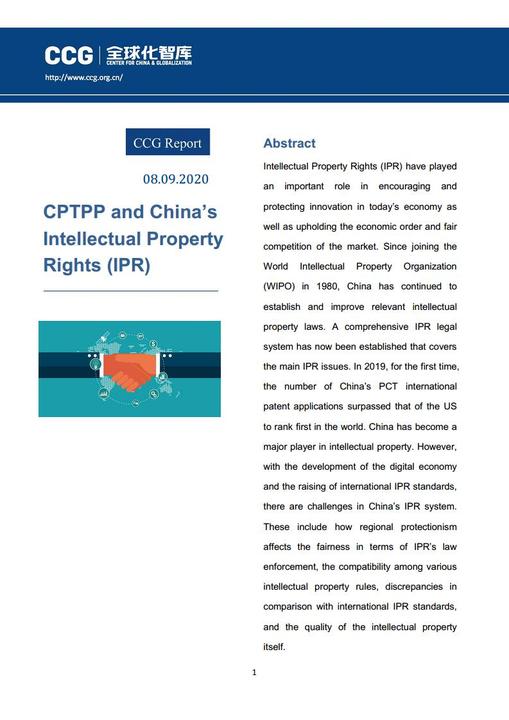Asia Economic and Trade Integration and China’s IPR

Intellectual Property Rights (IPR) have played an important role in encouraging and protecting innovation in today’s economy as well as upholding the economic order and fair competition of the market. Since joining the World Intellectual Property Organization (WIPO) in 1980, China has continued to establish and improve relevant intellectual property laws. A comprehensive IPR legal system has now been established that covers the main IPR issues. In 2019, for the first time, the number of China’s PCT international patent applications surpassed that of the US to rank first in the world. China has become a major player in intellectual property. However, with the development of the digital economy and the raising of international IPR standards, there are challenges in China’s IPR system. These include how regional protectionism affects the fairness in terms of IPR’s law enforcement, the compatibility among various intellectual property rules, discrepancies in comparison with international IPR standards, and the quality of the intellectual property itself.
The state of China’s IPR protection has certain impacts on China’s participation in regional and globalized economic development. With the development of a regionalized economy, stringent IPR protection standards are a barrier of entry for advanced Free Trade Areas (FTAs). The focus of this report is whether China’s IPR protection can align with high-standards enshrined in FTAs, in particular the Comprehensive and Progressive Agreement for Comprehensive and Progressive Trans-Pacific Partnership (CPTPP) that has higher standards than the World Trade Organization (WTO).
This report investigates and analyzes China’s IPR protection across three major dimensions. Firstly, the evolution of China’s IPR; Secondly, intellectual protection in the digital economy; Thirdly, comparisons between China’s intellectual protection and international standards. Following the evaluation of these three dimensions, the feasibility of China’s admissibility to the CPTPP will be explored from the IPR perspective.
Abstract
Intellectual Property Rights (IPR) play an important role in encouraging and protecting innovation in today’s economy and maintaining healthy competition. Since China joined the World Intellectual Property Organization (WIPO) in 1980, China has continued to establish and improve relevant intellectual property laws. A comprehensive IPR legal system has now been established covering the main IPR issues. In 2019, for the first time, the number of China’s PCT international patent applications surpassed the US to rank first in the world. China has become a major player in intellectual property. However, with the development of the digital economy and the raising of international IPR standards, there are challenges for China’s IPR system. These include how regional protectionism affects fairness in intellectual property law enforcement, the harmonization between various intellectual property rules, discrepancies with international IPR standards, and the quality of the intellectual property itself.
The state of China’s IPR protection has certain impacts on China’s participation in regional and globalized economic development. With the development of a regionalized economy, stringent IPR protection standards are entry barriers for advanced Free Trade Areas (FTAs). The focus of this report is whether China’s IPR protection can align with high-standard FTAs, in particular the Comprehensive and Progressive Agreement for Trans-Pacific Partnership (CPTPP) that has higher standards than the World Trade Organization (WTO).
This report investigates and analyzes China’s IPR protection across three major dimensions. Firstly, the evolution of China’s IPR; Secondly, intellectual protection in the digital economy; Thirdly, comparisons between China’s intellectual protection and international standards. Following the evaluation of these three dimensions, the feasibility of China’s admissibility to the CPTPP will be explored from the IPR perspective.
The CPTPP, previously called the Trans-Pacific Partnership (TPP), is a regional free trade agreement initiated by the United States. Due to its high standards for intellectual property protection and trade, it was once regarded as a threshold set by the United States to exclude China from its trade circle. In 2017, after the United States’ withdrawal from the TPP, Japan and other countries pushed for the Comprehensive and Progressive Agreement for Trans-Pacific Partnership (CPTPP), which was announced on Dec. 30, 2018. Following the withdrawal of the United States, China faces a limited window of time within which to join the CPTPP. By comparing the differences between China’s IPR law and CPTPP rules, the gap between Chinese and established international regulations becomes clear. If China joins the CPTPP, it will become a member of the largest FTA in the Asia-Pacific region, gaining access to 11 countries’ markets and a voice in current multilateral free trade area negotiations. At present, although there is controversy within China’s academic circles on whether China should join the CPTPP, the Chinese government has expressed a positive attitude towards joining.
Analyzing the three dimensions above, this paper provides preliminary observations and analysis on the current situation of intellectual property protection in China through an investigation of IT companies and exchanges with relevant legal and academic professionals. According to our research, even though China is a growing power in terms of IP, the quality of intellectual property, companies’ focus on intellectual property, and IPR education and laws can still be improved. At the same time, however, research shows that compared with international standards, China’s IPR laws and regulations are not far behind. Especially within the digital economic domain, China is innovating in digital economic IPR issues which can be seen in business models, technology, and techniques for protecting intellectual property. These include the use of blockchain technology to strengthen IPR protection, the development of business models and related products in the digital economy, and related developments in the field of IPR which are relatively advanced.
In early 2020, under the pressure of COVID-19, construction of “New Infrastructure” as a method to restore economic development entered into the national economic policy list. New infrastructure not only focuses on maintaining the growth of the digital economy, but also on creating new digital economy applications and management models, at the same time stimulating the commercial use of new technologies. These changes create challenges for the innovation and protection of intellectual property. It is predominantly revealed in the blurring of responsibilities and new challenges for relevant anti-monopoly laws. At the Two Sessions in May 2020, the Anti-Monopoly Law and digital economic innovation attracted a lot of attention. Some proposals suggest that the local People’s Procuratorates should be given the authority to file public interest cases against illegal anti-monopoly activities and take the burden of proof off small and medium-sized enterprises (SMEs), which typically are in a weaker position.
The findings of this paper suggest that issues related to local protectionism, which affect the fairness of IPR law enforcement, and difficulties for law enforcement are mainly related to factors such as regional economic disparities in China, the level of specialization of local law enforcement personnel, coordination between different agencies, and institutional factors such as the “Two-Track System” adopted by China on IPR, which lead to divergent local interests. In recent years, relevant departments have improved by setting up IPR courts and reorganizing the functions of the State IPR Office. At present, patent law and other relevant laws being revised to bring China’s IPR standards up to international standards. Overall, China’s IPR innovation has made great progress, and the level of IPR protection is improving steadily, but there is still room for improvement.
Based on the above comparison and analysis of the CPTPP’s regulations on IPR, this report holds that although some of China’s IPR protection standards fall behind CPTPP standards, the main problems are differences in the definition of certain terms; their implications need to be confirmed. There are also coordination problems between Chinese standards and laws, and some laws and regulations need to be further revised to align with the CPTPP. These problems will not create serious obstacles for China to join the CPTPP. At the same time, CPTPP member states reduced some IPR provisions as part of the negotiations following the withdrawal of the United States, making compatibility with China’s IPR standards easier to achieve.
In conclusion, the report proposes the following suggestions:
1.Start negotiations between China and CPTPP members.
2.Pay attention to the combination of the protection of IPR in China’s digital economy and the opening up of the economy. Examples of specific areas include the newly revised Copyright Law and clarity of the legal obligations of Internet service providers so as to strengthen copyright protection capabilities in the digital era. China should learn from the EU’s General Data Protection Regulations (GDPR) to innovate and develop data rights in the digital age and protect enterprises’ innovation and development.
3.Improve training of IP-related talent and achieve standardization. This includes the training of IPR workforce candidates in colleges and universities and the standardization of agency IPR qualifications and certifications. At the same time, we should strengthen the supervision of the national standard of “Enterprise IPR Management Regulation”, to prevent enterprises from not fully complying with the regulations.
4.Promote the application of IPR protection blockchain technology, management, and R&D. Prevent improper blockchain practices that erode trust in blockchain technology.
5.As Chinese technology companies move abroad, China’s foreign IPR protection needs improvement. Relevant ministries need to take measures to coordinate and strengthen the protection of China’s IPR abroad.
Full Report(Excerpts)
The CPTPP and China’s IPR
1. The History of the CPTPP
2. How Will Joining the CPTPP Influence China?
(1) International Relations
(2) Economic Development and Opening-Up
The CPTPP currently includes 11 member states, with a total economic output accounting for 13.2% of the global sum, and a total trade volume accounting for 15% of the global sum. It is the largest trade agreement in the Asia-Pacific region. If China joins the CPTPP, it will increase its share of the global economy to more than 30%, making it one of the largest free trade agreements in the world. At present, it is noteworthy that China is still a developing country, while the development after 40 years of Reform and Opening-up has been surmountable, even becoming the world’s second-largest economy more than ten years after China’s accession to the WTO. When considering the CPTPP agreement, it is also necessary to break away from the dualistic thinking in terms of “developed countries vs. developing countries,” but to consider the positive and negative impacts on China’s actual economic development, productivity improvement, and optimal allocation of resources.
3. The Challenges China Faces in Joining the CPTPP
(1) State-Owned Enterprises
(2) Labor Rights
(3) Intellectual Property
4. Literature Review
5. CPTPP: A case study comparing China’s IPR and international standards
The CPTPP’s IPR provisions have changed somewhat compared to previous TPP provisions but are still higher than TRIPs. The CPTPP covers a population of more than 500 million and 13.4% of global GDP. In terms of GDP, CPTPP is the world’s third-largest free trade area after the USMCA (formerly NAFTA) and the European Common Market. Its level of IPR protection is also the highest in the world.





